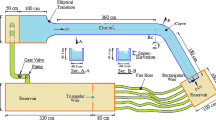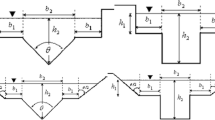Abstract
Open channel bends have fascinated engineers and scientists for decades while providing water for domestic, irrigation and industrial consumption. The presence of curvature in a channel impacts the flow pattern, velocity and water surface profile. Simulating flow variables such as velocity and water surface depth is one of the most important matters in the design and application of open channel bends. This study investigates a new neural network method using the radial basis function (RBF) based on decision trees (DT-RBF) to predict velocity and free-surface water profiles in a 90° open channel bend. In this study, 506 flow depth and 520 depth-averaged velocity field data obtained at 5 different discharges (5, 7.8, 13.6, 19.1 and 25.3 l/s) in a 90° sharp bend were used for training and testing purposes. The obtained results showed that the proposed DT-RBF models were more accurate than RBF models in estimating flow depth and depth-averaged velocity in the bend. The RBF root-mean-square error (RMSE), mean absolute error (MAE) and relative error (δ) were reduced by 20, 24 and 23.5%, respectively, when using the hybrid DT-RBF model to estimate the depth-averaged velocity. For water surface prediction, the RMSE, MAE and δ decreased by 33, 27.5 and 37%, respectively, when using the proposed DT-RBF hybrid model. For the longitudinal profiles of water surface profile prediction at the outer edge, MAE (0.018) improved to MAE (0.0084) with DT-RBF. It was found that the hybrid decision tree-based method significantly improved RBF neural network performance in forecasting the velocity and free-surface water profiles in a 90° open channel sharp bend.









Similar content being viewed by others
References
Kimura I, Takimoto S, Blanckaert K, Shimizu Y, Hosoda T (2010) 3D RANS computations of open channel flows with a sharp bend. In: Proceedings of the 6th international symposium on environmental hydraulics, Athens, Greece, 23–25 June 2010, pp 961–966
Shukry A (1950) Flow around bends in an open flume. Trans ASCE 115:751–788
Rozovskii IL (1961) Flow of water in bends of open channels. Academy of Sciences of the Ukrainian SSR, Israel Program for Science Translation, Jerusalem, pp 1–233
DeVriend HJ, Geoldof HJ (1983) Main flow velocity in short river bends. J Hydraul Eng 109(7):991–1011
Steffler PM, Rajartnam N, Peterson AW (1985) Water surface change of channel curvature. J Hydraul Eng 111(5):866–870
Ye J, McCorquodale JA (1998) Simulation of curved open channel flows by 3D hydrodynamic model. J Hydraul Eng 124(7):687–698
Blanckaert K, DeVriend HJ (2004) Secondary flow in sharp open-channel bends. J Fluid Mech 498:353–380
Uddin MN, Rahman MM (2012) Flow and erosion at a bend in the braided Jamuna River. Int J Sediment Res 27(4):498–509
Barbhuiya AK, Talukdar S (2010) Scour and three dimensional turbulent flow fields measured by ADV at a 90 degree horizontal forced bend in a rectangular channel. Flow Meas Instrum 21(3):312–321
Naji MA, Ghodsian M, Vaghefi M, Panahpur N (2010) Experimental and numerical simulation of flow in a 90° bend. Flow Meas Instrum 21(3):292–298
Akhtari AA, Abrishami J, Sharifi MB (2009) Experimental investigations water surface characteristics in strongly-curved open channels. J Appl Sci 9(20):3699–3706
Ramamurthy AS, Han S, Biron PM (2013) Three-dimensional simulation parameters for 90° open channel bend flows. J Comput Civil Eng 27(3):282–291
Gholami A, Akhtari AA, Minatour Y, Bonakdari H, Javadi AA (2014) Experimental and numerical study on velocity fields and water surface profile in a strongly-curved 90° open channel bend. Eng Appl Comput Fluid Mech 8(3):447–461
Vaghefi M, Akbari M, Fiouz AR (2015) Experimental investigation of the three-dimensional flow velocity components in a 180 degree sharp bend. World Appl Progr 5(9):125–131
Ghobadian R, Mohammadi K (2011) Simulation of subcritical flow pattern in 180° uniform and convergent open-channel bends using SSIIM3-D model. Water Sci Eng 4(3):270–283
Vaghefi M, Ghodsian M, Neyshabouri SAAS (2012) Experimental study on scour around a T-shaped spur dike in a channel bend. J Hydraul Eng 138:471–474
Han S, Ramamurthy AS, Biron PM (2011) Characteristics of flow around open channel 90° bends with vanes. J Irrig Drain Eng 137(10):668–676
Han S, Biron PM, Ramamurthy AS (2011) Three-dimensional modelling of flow in sharp open-channel bends with vanes. J Hydraul Eng 49(1):64–72
Beygipoor Gh, Bajestan MS, Kaskuli HA, Nazari S (2013) The effects of submerged vane angle on sediment entry to an intake from a 90 degree converged bend. Adv Environ Biol 7(9):2283–2292
Tayfur G (2002) Artificial neural network for sheet sediment transport. Hydrol Sci J 47(6):879–892
Kisi O (2004) River flow modeling using artificial neural networks. J Hydrol Eng 9(1):60–63
Partal T, Kisi O (2007) Wavelet and neuro-fuzzy conjunction model for precipitation forecasting. J Hydrol 342(1–2):199–212
Zeng Y, Huai W (2009) Application of artificial neural network to predict the friction factor of open channel flow. Commun Nonlinear Sci Numer Simul 14:2373–2378
Ghorbani MA, Khatibi R, Aytek A, Makarynskyy O, Shiri J (2010) Sea water level forecasting using genetic programming and comparing the performance with artificial neural networks. Comput Geosci 36(5):620–627
Riahi HM, Ayyoubzadeh SA, Atani MG (2011) Developing an expert system for predicting alluvial channel geometry using ANN. Expert Sys Appl 38(1):215–222
Akbari M, Solaimani K, Mahdavi M, Habibnejhad M (2011) Monitoring of regional low-flow frequency using artificial neural networks. J Water Sci Res 3(1):1–17
Zaji AH, Bonakdari H (2014) Performance evaluation of two different neural network and particle swarm optimization methods for prediction of discharge capacity of modified triangular side weirs. Flow Meas Instrum 40:149–156
Zaji AH, Bonakdari H (2015) Application of artificial neural network and genetic programming models for estimating the longitudinal velocity field in open channel junctions. Flow Meas Instrum 41:81–89
Petković D, Gocic M, Trajkovic S, Shamshirband S, Pavlović NT, Bonakdari H (2015) Determination of the most influential weather parameters on reference evapotranspiration by adaptive neuro-fuzzy methodology. Comput Electron Agric 114:277–284
Ebtehaj I, Bonakdari H (2015) Bed load sediment transport estimation in a clean pipe using multilayer perceptron with different training algorithms. KSCE J Civil Eng. doi:10.1007/s12205-015-0630-7
Tahershamsi A, Menhaj MB, Ahmadian R (2006) Sediment loads prediction using multilayer feedforward neural networks. Amirkabir J Sci Technol 16(63):103–110
Kumar B, Sreenivasulu G, Ramakrishna Rao A (2010) Radial basis function network based design of alluvial channels with seepage. J Hydrol Hydromech 58(2):102–113
Tahershamsi A, Majdzade Tabatabai MR, Shirkhani R (2012) An evaluation model of artificial neural network to predict stable width in gravel bed rivers. Int J Environ Sci Technol 9:333–342
Senthil Kumar AR, Ojha CSP, Manish Kumar G, Singh RD, Swamee PK (2012) Modeling of suspended sediment concentration at Kasol in India using ANN, fuzzy logic, and decision tree algorithms. J Hydrol Eng 17(3):394–404
Bonakdari H, Baghalian S, Nazari F, Fazli M (2011) Numerical analysis and prediction of the velocity field in curved open channel using artificial neural network and genetic algorithm. Eng Appl Comput Fluid Mech 5(3):384–396
Baghalian S, Bonakdari H, Nazari F, Fazli M (2012) Closed-form solution for flow field in curved channel in comparison with experimental and numerical analysis and artificial neural network. Eng Appl Comput Fluid Mech 6(4):514–526
Sahu M, Jana S, Agarwal S, Khatua KK (2011) Point form velocity prediction in meandering open channel using artificial neural network. In: 2nd International conference on environmental science and technology, vol 6. IACSIT Press, Singapore, pp 209–212
Gholami A, Bonakdari H, Zaji AH, Akhtari AA (2015) Simulation of open channel bend characteristics using computational fluid dynamics and artificial neural networks. Eng Appl Comput Fluid Mech 9(1):355–369
Gholami A, Bonakdari H, Zaji AH, Akhtari AA, Khodashenas SR (2015) Predicting the velocity field in a 90° open channel bend using a gene expression programming model. Flow Meas Instrum. doi:10.1016/j.flowmeasinst.2015.10.006
Chen W, Fu ZJ, Chen CS (2014) Recent advances in radial basis function collocation methods. Springer, Heidelberg
Kisi O (2008) The potential of different ANN techniques in evapotranspiration modelling. Hydrol Process 22:2449–2460
Coppersmith D, Hong SJ, Hosking JRM (1999) Partitioning nominal attributes in decision trees. Data Min Knowl Disc 3(2):197–217
Author information
Authors and Affiliations
Corresponding author
Rights and permissions
About this article
Cite this article
Gholami, A., Bonakdari, H., Zaji, A.H. et al. New radial basis function network method based on decision trees to predict flow variables in a curved channel. Neural Comput & Applic 30, 2771–2785 (2018). https://doi.org/10.1007/s00521-017-2875-1
Received:
Accepted:
Published:
Issue Date:
DOI: https://doi.org/10.1007/s00521-017-2875-1




